by Alex Walsh

Bill Nawrocki in 2006.
“Mr. Nawrocki, this is Greg Field. Listen, I’ve got to talk fast. I’m in LA, and I’m doing a recording. If it wasn’t for you I wouldn’t be here. I love you babe.”
“That’s one of my best memories,” says Bill, “I’m almost crying right now. I’m a softie.”
Bill Nawrocki is a first call drummer, an inspiring teacher, a veteran, a family man, and an avid golfer. His resume is peppered with big names such as Tony Bennett, Bing Crosby, and Bob Hope. Many of his students went on to musical success, such as traveling with the Lion King (John Mader), and playing with the Yellow Jackets (Will Kennedy). Greg Field went on to play drums for Frank Sinatra, Count Basie, and Henry Mancini. Bill remembers one time Field was in town with Frank Sinatra Jr., but couldn’t make the rehearsal. Field called Bill in, and Sinatra Jr. liked him so much that he asked him to be part of the show.
In the early 70s, Bill became Tony Bennett’s San Francisco drummer. “I was hired to go out to Hawaii with Connie Haines,” recalls Bill. “We were there for three weeks. On one of our off nights, Tony Bennett was going to do a television show in the ballroom. Tony saw our show, and afterwards he and his conductor came up to look over the band stand. Just as I was moving my drums out of the way, someone came up to tell them that Tony’s drummer couldn’t make it. Tony immediately said, ‘Get on the phone and get someone from LA.’ ‘Well, what about this guy?’ asked his conductor. Tony says, ‘You think he’ll do it?’ and I say, ‘Sure, I’ll do it!’ So I played the show and it was a success. And from then on, whenever Tony came to San Francisco, we were buddies.”
Born in Chicago in 1931, Bill is the elder of two brothers. His family is Polish and lived in the Polish neighborhood of Chicago’s South Side. His mother was a house wife and his father was a tool and dye maker who worked part time as a violinist. “It sounds like a strange combination, to be a tool and dye maker and a violinist,” says Bill, “But he was good enough to play casuals and lead the band at the Drake Hotel in Chicago in the summers.” His father was also an active member of the Chicago Federation of Musicians, Local 10, even serving on the Board of Directors.
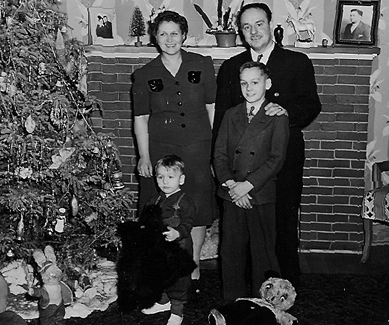
1940s Christmas. Bill with his parents, Pearl and Bill Sr., and younger brother Jerry.
Bill’s first love was baseball–the Chicago White Sox (now it’s the A’s). Growing up, his house was filled with music and baseball. He has fond memories of listening to one great band after another on the radio all day long on Sundays. When he was ten, his father, a very strict man, set him up for violin lessons. Soon, Bill began losing sleep over the fact that he hated the violin. After four lessons he finally got up the nerve to tell his father, who surprised him by asking what he wanted to play. “Well, I like the drums,” said Bill. ”Okay,“ said his father, ”but you damn well better practice.”
In high school, Bill tried out for the baseball team, but the coach wouldn’t let him on the field because he was too short. Bill was devastated, but soon devoted himself to music, playing in the school band and an after-school quartet—working his first paying gig in a bar when he was sixteen. Soon after, he joined Local 10. His band played weekly and included accordion, clarinet/sax, bass, and drums. “The other guys were all Italian. I was the only odd ball in there,” says Bill, “We used to rehearse over at the clarinet player’s house. His mother would make us a nice pizza for lunch.”
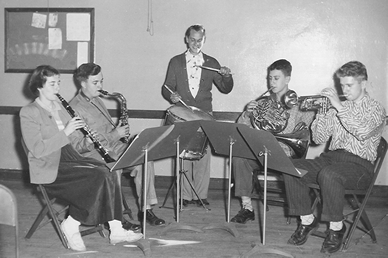
1948, High School Band.
After high school, Bill lived at home and attended the Knapp School of Percussion in Chicago on a scholarship. He took various part-time jobs, and any money he made went directly to his parents. In 1951, he joined the Air Force rather than being drafted. He chose the Air Force because they had a full-time band.

1951, in the Air Force.
Bill did basic training in Texas. “I became very popular because I would volunteer for all the crappy details at night,” says Bill, “This gave me time to practice.” After basic training, Bill went to band school. In 1952, he was stationed at Parks Air Force Base in Dublin—a long way for a kid who had never been outside of Chicago! In 1953, Bill was sent to percussion school in Washington D.C. for three months. He went in as a corporal and came out a staff sergeant.
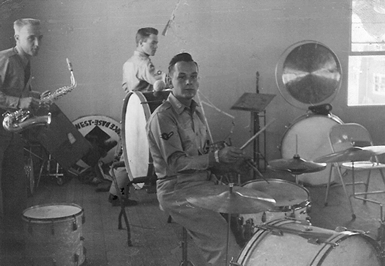
Air Force Band practice.
“Every once and a while, the USO would do shows on the base,” recalls Bill. “My buddy said he was dating a singer in the show who had a cousin who was a dancer in the show.” Bill saw the show at the Officers Club (he was able to get in because he was a musician) and met his future wife, Isabel, afterwards. For the next year they saw quite a bit of each other and were soon engaged to be married.
“We talked a lot,” says Bill. “The fact that we were both in the entertainment business was a big plus. We understood each other. Isabel wanted her own dance studio so she could teach. She didn’t want to go on the road. I wanted to be a drummer.” When Bill was transferred back to Texas, they saw each other whenever he could get time off. In 1954, they married. Isabel moved to Texas and became a typist on the base. Bill was released from duty in September ’56, and they returned to Oakland.
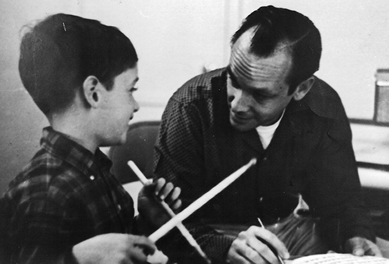
1965 with student Kim Plainfield who went on to be a professional musician.
1965 with student.
Settling into their new life, Isabel started a dance studio with a friend. Bill joined Local 6 right away, but he didn’t have the contacts to get any work. Isabel’s uncle, accordionist Alfred Capelli, got Bill his first job, a New Year’s Eve gig. Her mother got him a job in the newspaper distribution plant where she worked. He worked there for three years. During that time he played a few casuals here and there, and taught students at Best Music. In 1959, he was excited to finally be hired to play a fulltime gig—at Fisherman’s Wharf in San Francisco—so excited that he quit his job at the factory. But at the last minute, the gig fell through. Instead of going back to the factory, he decided to take on more students. Eventually, bandleader Phil Bovaro booked him for a gig, and Bill started to work more.
On one of his gigs, Bill met trumpeter Bill Wagner. Wagner recommended Bill to Del Courtney, a well established bandleader who was playing at the Claremont Hotel in Berkeley. After Bill played the gig, Del asked him to join the band for a steady every Saturday. “When the word got out that I was good enough to play with Del, I started getting lots of calls for casuals from top players,” says Bill, “I had to make sure I gave Courtney first call.”

1960s Raiders game with Del Courtney’s Band.
In 1961, the Nawrocki’s had their first child, and five years later, their second. By now Bill was an established first call drummer. Along with Del Courtney, Bill also played the relief nights at Bimbo’s with Bill Weir. He did theater work, recording work, and some traveling with Del Courtney, most notably with the King Family in the late 1960s. When the Giants moved to San Francisco, Courtney became the house band for the games, and Bill was out at Candlestick every weekend during the summer. When The Raiders came to Oakland, Courtney also got that contract, and Bill played there as well. “When I started playing the sports arenas, my parents moved out from Chicago just so they could see me playing.”
In the 1970s, Bill continued to play casuals, along with the occasional Broadway Show, including Annie, Guys and Dolls, and The Rat Pack. He was a bandleader for quite a few cruise lines, including Sitmar, Royal Viking, and Princess Lines. He continued to work for Del Courtney until the early 1980s, when Courtney moved to Hawaii.
During this time, Bill served on the Local 6 Board of Directors for six years, going out to lunch with Vernon Alley at the Bohemian Club after every meeting. Both avid golfers, Bill says Vernon was there when he hit his first hole in one. “You got it in, Knockers!” screamed Vernon. (‘Knockers’ was Bill’s nickname).
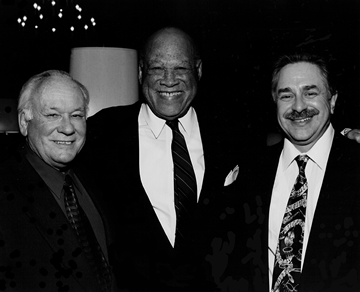
Bill with Vernon Alley and Ed Margolin.
Today, Bill is still actively playing. After our interview, he was off to a rehearsal for a show that night. “I’ve got a lot of religion, man, “says Bill, “I’m thankful. I’m thankful. That’s what it’s all about.”
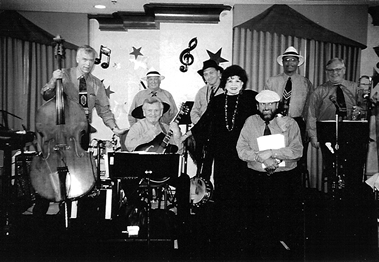
Bill with the Pat Yankee Group in 2006.
Bill Nawrocki has backed or traveled with:
Tony Bennett, Frankie Laine, Connie Haines, Helen O’Connell, Ernie Ford, The King Sisters, Steve Lawrence and Edie Gorme, Mary Martin, Bing Crosby, Bob Hope, Milton Berle, The Ink Spots, The Mills Brothers, Joe Williams, Pat Yankee, Rosemary Clooney, Keely Smith, Page Cavanaugh.
Bands: Tex Beneke, Del Courtney, Bob Crosby, Leo Schilling, George Shearing, Les Elgart, Muggsy Spanier, Red Nichols, Billy Taylor Quartet, Ernie Heckscher, Rudy Salvini.
